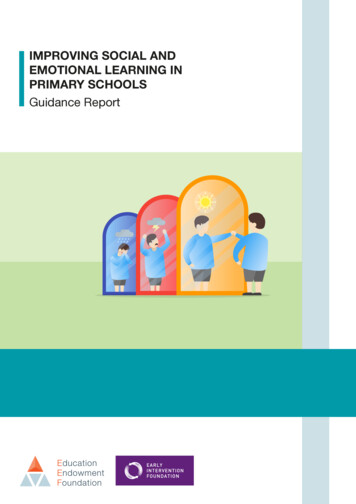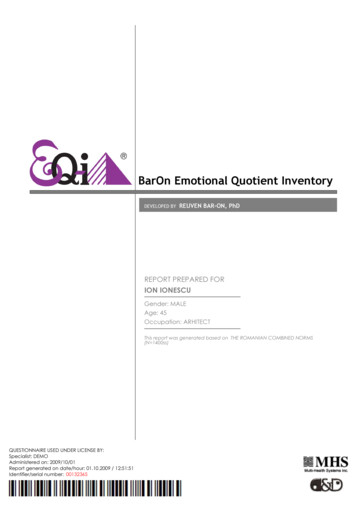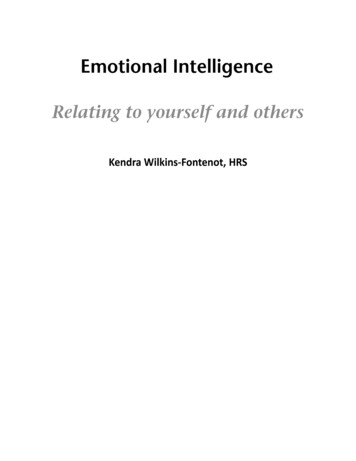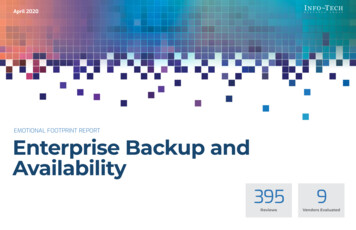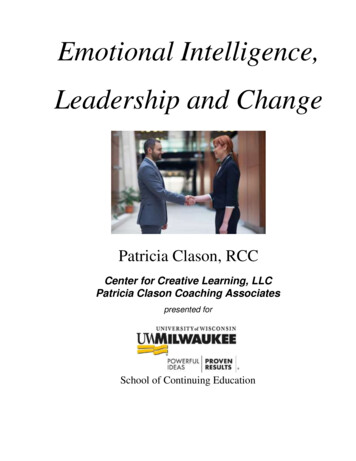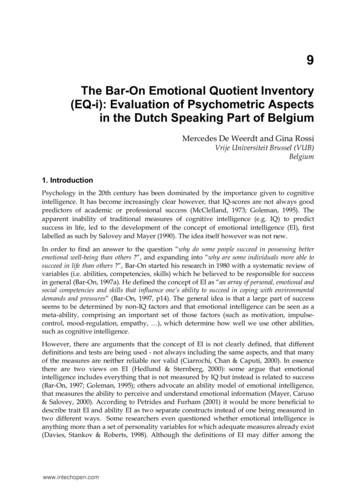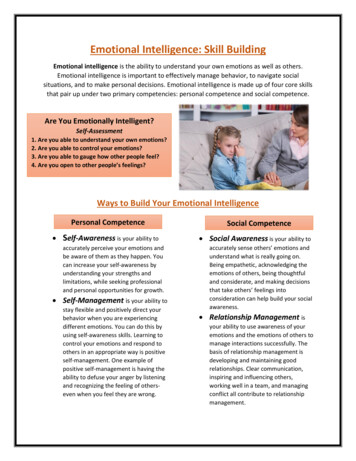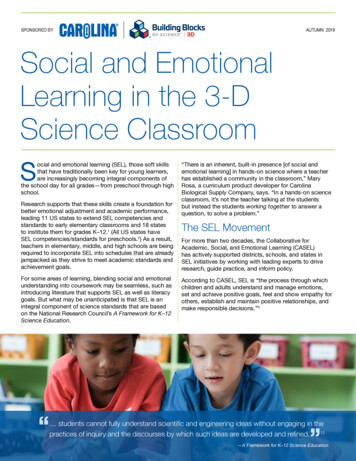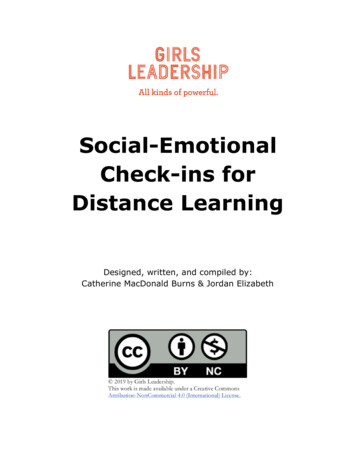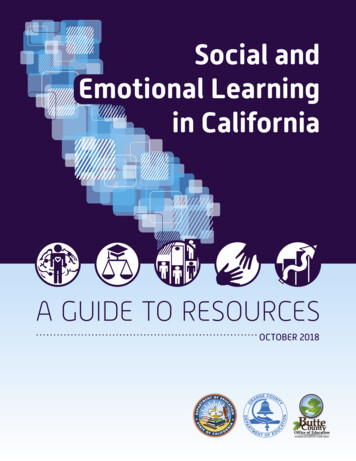
Transcription
Social andEmotional Learningin CaliforniaA GUIDE TO RESOURCESOCTOBER 2018
PUBLISHING INFORMATIONSocial and Emotional Learning in California: A Guide to Resources wasdeveloped by a cross-agency project team that included PamelaMcVeagh-Lally, Luzy Vezzuto, Sandra Azevedo, and Johanna Parra.This publication was edited by Tom Wyant, California Department ofEducation, working in cooperation with Pamela McVeagh-Lally andRoxane Fidler. It was designed and prepared for online posting by CDEPress staff, with the cover and layout designed by Aristotle Ramirez.It was published by the Department of Education, 1430 N Street,Sacramento, CA 95814. It was distributed under the provisions of theLibrary Distribution Act and Government Code Section 11096. 2018 by the California Department of EducationAll rights reserved. Reproduction of this document for resale, in whole orin part, is not authorized.NOTICEThe guidance in Social and Emotional Learning in California: A Guide toResourcesis not binding on local educational agencies or other entities.Except for the statutes, regulations, and court decisions that arereferenced herein, the document is exemplary, and compliance with it isnot mandatory. (See Education Code Section 33308.5.)
CONTENTSAcknowledgments413. IPEN Learning Library37Introduction514. National Center on SafeSupportive Learning Environments39Guide Design742How to Use the Guide915. The National Child TraumaticStress NetworkResource Snapshots1216. National Education Association–Diversity Toolkit441. ACT (Assets Coming Together)For Youth–Social and EmotionalLearning Toolkit13462. ASCD Whole Child Approach153. CASEL District Resource Center174. CASEL Guide (2013): EffectiveSocial and Emotional LearningPrograms—Preschool andElementary School Edition1917. Navigating SEL from the InsideOut–Looking Inside and Across 25Leading SEL Programs:A Practical Resource for Schoolsand OST Providers (ElementarySchool Focus)18. NBC News Parent Toolkit48505. CASEL Guide (2015): EffectiveSocial and Emotional LearningPrograms—Middle and High SchoolEdition2119. Preparing Youth to Thrive:Promising Practices for Social &Emotional Learning526. Center on the Social andEmotional Foundations for EarlyLearning2320. Restorative Practices: FosteringHealthy Relationships & PromotingPositive Discipline in Schools, AGuide for Educators547. Character Lab2521. SEL School: Connecting Socialand Emotional Learning to EffectiveTeaching, The8. Communities in Schools,Central Texas–Trauma Training forEducators2722. Social and Emotional LearningResource Finder5623.Students at the Center Hub589. Edutopia2924. Teaching Tolerance6010. Heart-Mind Online3125. Transforming Education Toolkits6311. Incorporating Social andPersonal Competencies IntoClassroom Instruction andEducator Effectiveness: A Toolkitfor Tennessee Teachers andAdministrators3326. State Resources and Examples6527. California District Examples67Social and EmotionalLearning Measurement69Future Directions12. inspirED357172Methods
ACKNOWLEDGMENTSCDE sincerely thanks the project team, the Guide Advisory Workgroup, and the larger Socialand Emotional Learning State Team, for their time, dedication, and contributions to curatingthis resource for California’s educators.Social and Emotional Learning in California: A Guide to Resources (Guide) was developedby a cross-agency project team: Pamela McVeagh-Lally, Social and Emotional LearningConsultant/California SEL State Team Consultant (team co-lead); Luzy Vezzuto PhD,Orange County Department of Education, Coordinator, Student Mental Health and Socialand Emotional Learning (team co-lead); Sandra Azevedo, MTSS Coordinator, ButteCounty Department of Education; and Johanna Parra, Program Specialist, Orange CountyDepartment of Education.SEL State Team Guide Advisory Workgroup Brent Malicote, SEL State Team co-lead/Sacramento County Office of Education; Katie Brackenridge, Partnership for Children and Youth; Michael Funk, Expanded Learning, California Department of Education; Curtiss Sarikey, Oakland Unified School District; Mary Hurley, SEL Consultant (formally Oakland Unified School District); Channa Cook Harvey, Learning Policy Institute; Hanna Melnick, Learning Policy Institute; and Susan Ward Roncalli, Los Angeles Unified School District.Thank you to Stuart Foundation, S.D Bechtel Jr. Foundation, and the CDE Foundation forsupporting the State Team’s work and the creation of the Guide. Thank you to JenniferPeck, SEL team co-lead, California Department of Education and Partnership for Childrenand Youth, Christine Olmstead, Associate Superintendent, Orange County Department ofEducation, and Julia Agostinelli, Aileen Allison-Zarea, Jennifer Howerter, and Roxane Fidler,California Department of Education. Additional thanks to Lisette Moore-Guerra, MiriamStevenson, Josh Bloom, and colleagues at Palo Alto Unified, and SEL team members MeleLau Smith, San Francisco Unified, and Mai Xi Lee, Sacramento City Unified. CDE extendsgratitude to the state education agencies in Massachusetts, Minnesota, Tennessee, andWashington, as well as Laura Hamilton, RAND Corporation, and Jeremy Taylor, LindaDusenbury, Roger Weissberg, Tyrone Martinez-Black, Heather Schwartz, and all our partnersat CASEL.4
INTRODUCTIONSocial and Emotional Learning in California: AGuide to Resources (Guide) is a project of the CDESEL State Team, a State Superintendent of PublicInstruction initiative, catalyzed by California’sparticipation in the Collaborative for Academic,Social, and Emotional Learning’s (CASEL)Collaborating States Initiative. Launched in 2016,and comprised of representatives from more than20 California education organizations and systems,the State Team seeks to affirm SEL as an essentialcomponent of a well-rounded, quality education inall youth-serving settings.Social and EmotionalLearning in California:A Guide to Resourcessupports the CaliforniaDepartment of Education’s(CDE) focus on social andemotional learning (SEL) asan essential component ofa high-quality education.As stated by The Aspen Institute’s National Commission on Social, Emotional, and AcademicDevelopment Council of Distinguished Educators:“Weaving together social, emotional, and academic development createshigh-quality learning environments in schools and classrooms. In theseenvironments, children can confidently do their best work because theyinteract with a cooperative and welcoming community of learners. Whensocial, emotional, and academic development are deliberately and thoughtfullyinterconnected, students benefit from learning experiences that enrich theirunderstanding of academic content and strengthen their critical thinking skills.Such experiences enable students to be more effective contributors in theirclassrooms today and in their workplaces and communities tomorrow.”In 2017, the CDE SEL State Team collaborated on creating California’s Social and EmotionalLearning Guiding Principles (SEL Guiding Principles), a set of statements intended to provideguidance to education leaders and to support the strong SEL work happening across thestate:1. Adopt Whole Child Development as the Goal of Education2. Commit to Equity3. Build Capacity4. Partner with Families and Community5. Learn and ImproveThe State Team also identified the goal of curating a collection of systematically gathered,comprehensive, and free resources that are aligned with the SEL Guiding Principles.Developed and curated by a cross-agency project team, this vetted resource collection, or5
Guide, allows California educators to easily access resources as systems move forward withlocal SEL priorities. Additionally, the Guide offers a short list of SEL resources created by fourstates participating in the CASEL Collaborating States Initiative: Massachusetts, Minnesota,and Washington, and a non-CSI state, Tennessee. Also included are resources created byCalifornia local education agencies (LEAs) leading the way on systemic SEL: Los AngelesUnified School District (LAUSD), Oakland Unified School District (OUSD), Palo Alto UnifiedSchool District (PAUSD), Sacramento City Unified School District (SCUSD), and San FranciscoUnified School District (SFUSD).6
GUIDE DESIGNThe Guide provides educators and practitionersThe Guide is a curatedwith high-quality, vetted resources to support thecollection of detailedimplementation of local SEL initiatives during the“snapshots” of high-quality,school day, in expanded learning environments,vetted resources forand in other youth-serving settings. Thoughpractitioners that supportthere are hundreds, if not thousands, of SELSEL implementation and areresources available to educators, the capacityaligned with the Californiaeach district, school, or educator has to combSEL Guiding Principles.through the available resources and discern theirvalue is often limited by time and expertise. Inthe interest of providing a substantive set ofresources that furthers the goals articulated inthe SEL Guiding Principles, this Guide offers a one-to-two-page, information-rich “snapshot”of each resource in an accessible format that identifies which SEL Guiding Principle(s)the resource aligns with and describes the resource’s intended purpose, user, population,developers, origins, content, and strengths. Using the snapshot information, educators andpractitioners can compare and contrast resources and select, for a more in-depth review,those that most closely meet locally identified goals.The Guide highlights toolkits and online resource centers rather than stand-alone tools.Multiple resources offer guidance on a systemic approach to SEL implementation andcontinuous improvement processes in a variety of educational settings, which aligns withthe spirit of the SEL Guiding Principles. Other resources provide targeted information andsuites of tools to support particular aspects of the SEL Guiding Principles and sub-principles.Adopting a systemic approach to SEL includes considering how SEL is integrated within amulti-tiered system of support (MTSS); however, this Guide currently places an emphasis onresources relevant to the foundational, universal tier of MTSS.The Guide is primarily intended for an audience of practitioners: Pre-K–12 educators,administrators, district staff, and expanded learning staff. The resources are often relevantto other student support staff, such as counselors. A small number of resources includedare directly relevant to other stakeholders such as families, high school students, highereducation professionals, and teacher educators. (See “snapshot” template on pages 10-11).The selection criteria for the Guide resources includes the following: Free to access and available online Created by a reputable education organization A suite of resources (rather than an individual resource)7
Includes research-based approaches and tools (i.e. adheres to effective practicesas determined in the SEL research literature or the research in a connected field ofstudy) Relevant to districts, schools, or classrooms, including expanded learning settings Largely aligned with SEL Guiding Principles (not offering contradictory practices orapproaches) Already be in use in the nation’s public schoolsThe Guide is available in two formats:1. PDF document with links to resources2. Searchable entries on Collaboration in Common, a free online professional learningcommunity and resource exchange platform available to all California educators8
HOW TO USETHE GUIDEAs LEA staff form SEL teams to develop a systemicapproach to SEL initiatives, or educators and otherpractitioners seek resources to implement in theirschools, classrooms, and expanded learning settings,searches within the Guide may be conducted usingseveral criteria, including: By user By student populationThe resources areorganized by userfriendly criteria andcan be accessedthrough Collaborationin Common (CIC). By SEL Guiding Principle(s)On CiC, the resources are tagged and searchable usingthese three criteria. Many of the SEL Guiding Principles are applicable to the majority of theresources based on the robust nature of many of the toolkits and online centers. The ProjectTeam, who conducted the resource reviews, also sought to identify the broadest applicationof the resources. For example, many resources designed for traditional school-day purposesare applicable to expanded learning settings and are therefore tagged for use by expandedlearning staff.9
Example search scenario: A district SEL coordinator is interested in viewing resourcesdesigned for elementary schools that promote SEL Guiding Principle 1A (Systems Change).The user would select the tags: district office staff, elementary school students, and 1) AdoptWhole Child Development as the Goal of Education A) Systems change, and the relevantresources would be prioritized in the user’s feed on CiC.The below format is the Guide “snapshot” template with descriptions of each category:TitleThe title of the document or online resource center as shown on the resourcePurposeThe purpose the resource is designed to serveLinkHyperlink to the resourceFormatAn online resource center (i.e. web site with downloadable, multimedia resources) and/ordocument, with page count (i.e. a stand alone Guide, toolkit, or field guide)Authors and ContributorsIndividual or organization who authored the documentUserThe user or audience designated in the resource: Pre-K educators, elementary schooleducators, middle school educators, high school educators, elementary schooladministrators, middle school administrators, high school administrators, counselors,expanded learning staff (after-school and out-of-school program staff), community-basedorganization staff, families, teacher educators, district office staff, high school students,higher educationStudent PopulationTargeted student population: Pre-K students, elementary school students, middle schoolstudents, high school students, pre-service teachers in preparation programsContextInformation on the organization/agency that developed the resource, including the catalystand process for development, if availableContentObjective description of the resource content in bullet point formatStrengthsParticular strengths of the resource as determined by project team10
SEL Guiding Principles AddressedA list of the Principles and sub-principles the resource addresses1. Adopt Whole Child Development as the Goal of EducationA. Systems changeB. Diverse and inclusive leadership teamsC. Social and emotional skills developmentD. Student-centered discipline policies and practicesE. Climate and culture2. Commit to EquityA. Address the opportunity gapB. Ensure representationC. Student and adult-ledD. Healing-informed3. Build CapacityA. Positive relationships and belongingB. Student and adult competenciesC. Developmental standardsD. Pre-service training and ongoing professional development4. Partner with Families and CommunityA. Family engagementB. Expanded learningC. Early learningD. Community partnerships5. Learn and improveA. Implementation plans and progress monitoringB. MeasurementAs noted, there are snapshots offering a short list of links to resources created by four SELfocused states: Massachusetts, Minnesota, Washington, and Tennessee. These resourcesinclude: SEL standards, benchmarks, and indicators; an implementation and assessmentguide; and professional learning resources such as online modules and a coaching toolkit.Also included in a snapshot format are a set of resources and examples created by CaliforniaLEAs, leading the way on systemic SEL: LAUSD, OUSD, PAUSD, SCUSD, and SFUSD.11
RESOURCE SNAPSHOTSNote: Current as of April 2018Contents1. ACT (Assets Coming Together) ForYouth—Social and Emotional LearningToolkit17. Navigating Social and EmotionalLearning from the Inside Out—Looking Inside and Across 25 LeadingSEL Programs: A Practical Resourcefor Schools and OST Providers)Elementary School Focus2. ASCD Whole Child Approach3. CASEL District Resource Center4. CASEL Guide (2013), Effective Socialand Emotional Learning Programs,Preschool and Elementary SchoolEdition18. NBC News Parent Toolkit19. Preparing Youth to Thrive: PromisingPractices for Social & EmotionalLearning5. CASEL Guide (2015), Effective Socialand Emotional Learning Programs,Middle and High School Edition20. Restorative Practices: FosteringHealthy Relationships & PromotingPositive Discipline in Schools, A Guidefor Educators6. Center on the Social and EmotionalFoundations for Early Learning21. SEL School: Connecting Social andEmotional Learning to EffectiveTeaching, The7. Character Lab8. Communities in Schools, CentralTexas—Trauma Training for Educators22. Social and Emotional LearningResource Finder9. Edutopia10. Heart-Mind Online23. Students at the Center Hub11. Incorporating Social and PersonalCompetencies Into ClassroomInstruction and EducatorEffectiveness; A Toolkit for TennesseeTeachers and Administrators24. Teaching Tolerance25. Transforming Education Toolkits26. State Resources and Examples27. California District Resources andExamples12. inspireEd13. IPEN Learning Library14. National Center on Safe SupportiveLearning Environments15. National Child Traumatic StressNetwork16. National Education AssociationDiversity Toolkit12
1ACT (Assets Coming Together) For Youth–Social andEmotional Learning ToolkitPURPOSEThe social and emotional learning (SEL) Toolkit offers web-based resources to helpyouth-serving practitioners provide opportunities for social and emotional learning forstudents. This toolkit uses the Collaborative for Academic, Social, and Emotional Learning(CASEL) Framework to describe a set of instructional practices and resources that can beincorporated into any youth programming.LINKhttp://www.actforyouth.net/youth development/professionals/sel/FORMATOnline resource centerAUTHORS AND CONTRIBUTORSThe SEL Toolkit was assembled by the Riskand Thriving in Adolescence Program workteam, a collaboration of Cornell University,Cornell Cooperative Extension, New YorkState 4-H Youth Development, and externalstakeholders.USERElementary school educatorsMiddle school educatorsHigh school educatorsExpanded learning staff (after-school andout-of-school program staff)Community-based organization staffFamiliesSTUDENT POPULATIONPre-KElementary schoolMiddle schoolHigh schoolCONTEXTACT (Assets Coming Together) for Youth Center of Excellence (YCE) connects research topractice in the areas of positive youth development and adolescent health. Funded by theNew York State Department of Health, the YCE provides resources, technical assistance,training, and evaluation services.13
CONTENTSTRENGTHS User-friendly Multimedia resources Uses CASEL’s corecompetency areas Can be incorporated into anyyouth programmingThe SEL Toolkit offers web-based resources tohelp youth-serving practitioners provide SELopportunities. Resources include manuals, activities, factsheets, videos, and websites. Uses CASEL’s core competency areas toorganize a set of instructional practicesand resources promoting SEL and may beincorporated in any youth programming. Corecontent areas include:A. Self-awarenessB. Self-managementC. Social awarenessD. Relationship skillsE. Responsible decision-makingSEL GUIDING PRINCIPLES ADDRESSED1. Adopt Whole Child Development as the Goal of EducationC. Social and emotional skills developmentE. Climate and culture2. Commit to EquityC. Student and adult-led3. Build CapacityA. Positive relationships and belongingB. Student and adult competenciesC. Developmental standards4. Partner with Families and CommunityD. Community partnerships5. Learn and Improve (Continuous Improvement)A. Implementation plans and progress monitoringB. Measurement14
2ASCD Whole Child ApproachPURPOSEASCD’s Whole Child Approach resources are designed to support educators, families,community members, and policy makers to adopt and take action on a set of schoolimprovement practices and “Whole Child Tenets” to promote an approach to education thatintegrates physical, emotional, and social health and wellbeing with academic learning.LINKhttp://www.ascd.org/whole-child.aspx and http://www.wholechildeducation.orgFORMATAUTHORS AND CONTRIBUTORSOnline resource centerASCDUSERElementary school educatorsMiddle school educatorsHigh school educatorsExpanded learning staff (after-school andout-of-school program staff)Community-based organization staffFamiliesSTUDENT POPULATIONPre–KElementary schoolMiddle schoolHigh schoolCONTEXTASCD is a nonprofit education membership and advocacy organization with more than125,000 members, including superintendents, principals, teachers, and advocates from morethan 138 countries. ASCD is “dedicated to excellence in learning, teaching, and leading sothat every child is healthy, safe, engaged, supported, and challenged.” ASCD offers free andpurchasable professional learning resources including Educational Leadership magazine,books, online courses, videos, conferences, interest group networks, policy advocacyresources, and school improvement consulting services.15
CONTENTSTRENGTHS Resourcedeveloped bywidely respected,75-year oldeducationmembershiporganization. Many freeresources andarticles. HelpfulFrameworkfor a systemsapproachto academiclearning, andsocial, emotional,and physicalwell-being. Strong needsassessment tool. Strong advocacyresources.Online resources, tools, and downloadable documentsbased on promoting school improvement through theWhole Child Tenets of “healthy, safe, engaged, supported,and challenged.”¡¡Indicatorsof a whole-child approach.¡¡ASCDSchool Improvement Tool, a needs assessmentsurvey.¡¡InServiceblog, with classroom and school tools andresources¡¡CommunityConversations toolkit that includes afacilitator’s guide and materials for stakeholderdiscussions and planning.¡¡Makingthe Case Advocacy Tool.videos on the details of the WholeSchool, Whole Community, Whole Child Framework, andexemplar schools.¡¡Informational Whole School, Whole Community, Whole Child. Searchable “what works” examples and resources. Whole Child Podcast and Archives. Thousands of searchable resources available on thebroader ASCD site and Educational Leadership magazinethat offer relevant information on SEL and related topics.SEL GUIDING PRINCIPLES ADDRESSED1. Adopt Whole Child Development as the Goal of EducationA. Systems changeB. Diverse and inclusive leadership teamsC. Social and emotional skills developmentD. Student-centered discipline policies and practicesE. Climate and culture2. Commit to EquityA. Address the opportunity gapC. Student and adult-ledD. Healing-informed3. Build CapacityA. Positive relationships and belongingB. Student and adult competenciesD. Pre-service training and ongoing professional learning4. Partner with Families and CommunityA. Family engagementB. Expanded learningD. Community partnerships16
3CASEL District Resource CenterPURPOSEThe Collaborative for Academic, Social, and Emotional Learning (CASEL) District ResourceCenter (DRC) supports planning for systemic implementation of district-wide, school-based,and community-based social and emotional learning (SEL) initiatives.LINKhttps://drc.casel.orgFORMATAUTHORS AND CONTRIBUTORSOnline resource centerCASEL, 2017; Various contributing schooldistrictsUSERPre-K educatorsElementary school educatorsMiddle school educatorsHigh school educatorsElementary school administratorsMiddle school administratorsHigh school administratorsCounselorsExpanded learning staff (after-school andout-of-school program staff)STUDENT POPULATIONPre-KElementary schoolMiddle schoolHigh schoolCONTEXTCASEL is nonprofit practice, research, and policy organization, dedicated to advancing thescience and practice of school-based SEL. CASEL’s mission is to make SEL an integral partof education from preschool through high school. The CASEL DRC is a product of CASEL’sCollaborating Districts Initiative, a partnership with large urban school districts across thenation, with the goal of studying systemic SEL implementation. Lessons learned from theparticipating school districts are distilled into the CASEL DRC theory of action.17
CONTENTSTRENGTHS Developed by the SEL field’sflagship organization. A one-stop shop for SELinitiative implementationoffering hundreds of resources. A wealth of district-developedtemplates, documents, andartifacts for downloading andadaptation. User-friendly. A district profile can becreated and updatedthrough the priority-settingquestionnaire.A comprehensive framework of 10 essentialareas for systematic district-wide, schoolbased implementation of SEL initiatives:communication, vision, align resources, buildexpertise, needs assessment, professionallearning, integration, programming, standards,and continuous improvement. Implementation process guides, programreviews, videos, webinars, rubrics, and schooldistrict artifacts. Priority-setting questionnaire to guidestep-by-step efforts with best practices forimplementing SEL initiatives. Resource library of tools and artifacts by topic. 30-minute webinar for guidance on using theCASEL DRC.SEL GUIDING PRINCIPLES ADDRESSED1. Adopt Whole Child Development as the Goal of EducationA. Systems changeB. Diverse & inclusive leadership teamsC. Social and emotional skills developmentD. Student-centered discipline policies and practicesE. Climate and culture3. Build CapacityA. Positive relationships and belongingB. Student and adult competenciesC. Developmental standardsD. Pre-service training and ongoing professional development4. Partner with Families and CommunityA. Family engagementB. Expanded learningD. Community partnerships5. Learn and improveA. Implementation plans and progress monitoringB. Measurement18
4CASEL Guide (2013):Effective Social and Emotional Learning Programs—Preschool and Elementary School EditionPURPOSEThe guide gives educators information for selecting and implementing well-designed, highquality, and evidence-based social and emotional learning (SEL) programs in preschools andelementary schools and districts. These programs are designated “CASEL entary-edition-casel-guide/FORMATAUTHORS AND CONTRIBUTORSDocument, 75 pagesCollaborative for Academic Social andEmotional Learning (CASEL), 2013USERPre–K educatorsElementary school educatorsElementary school administratorsCounselorsExpanded learning staff (after-school andout-of-school program staff)Community-based organization staffDistrict office staffSTUDENT POPULATIONPre–KElementary schoolCONTEXTCASEL is nonprofit practice, research, and policy organization, dedicated to advancing thescience and practice of school-based SEL. CASEL’s mission is to make SEL an integral part ofeducation from preschool through high school. The 2013 Guide is the second and updatededition originally published in 2003 titled Safe and Sound: An Education Leaders Guide toEvidence-based Social and Emotional Learning.19
CONTENTSTRENGTHS Overview of SEL. Ratings of 25 evidence-based, classroomfocused SEL programs for preschool and K–5that include direct social and emotional skillsinstruction, pedagogy and teacher instructionalpractices, and integration of SEL into academicsubjects.Developed by the SEL field’sflagship organization. Rigorous criteria for programinclusion in the guide. One of few comprehensiveguides to evidence-basedSEL program selection andadoption. Accessible and comprehensiveratings tables and appendix ofprogram descriptions. Strong selection andimplementation guidelines forusers. Developmentallydifferentiated. Best practice guidelines for program selectionand implementation, including CASEL’s Districtand School Theories of Action for Systemic SEL. Appendix of program descriptions. Additional information on programinclusion criteria, ratings framework, andrecommendations for future priorities toadvance SEL practice, policy, and research.SEL GUIDING PRINCIPLES ADDRESSED1. Adopt Whole Child Development as the Goal of EducationA. Systems changeB. Diverse and inclusive leadership teamsC. Social and emotional skills developmentD. Student-centered discipline policies and practicesE. Climate and culture2. Commit to EquityA. Address the opportunity gapC. Student and adult-led3. Build CapacityA. Positive relationships and belongingB. Student and adult competenciesC. Developmental standardsD. Pre-service training and ongoing professional learning4. Partner with Families and CommunityA. Family engagementB. Expanded learningD. Community partnerships5. Learn and Improve (Continuous Improvement)A. Implementation plans and progress monitoringB. Measurement20
5CASEL Guide (2015): Effective Social and EmotionalLearning Programs—Middle and High School EditionPURPOSEThe guide gives educators information for selecting and implementing well-designed, highquality and evidence-based social and emotional learning (SEL) programs in middle and highschools and districts. Based on the program’s design and evidence base, each is designated“CASEL SELect,” indicating that the program met all inclusion criteria and is highly recommended,or the program is identified as “complementary” or “promising,” meaning the programdid not meet all inclusion criteria but is well-designed and has evidence of effectiveness.(Complementary and Promising program descriptions available only in online ool-edition-casel-guide/Online program descriptions: tmlFORMATAUTHORS AND CONTRIBUTORSDocument, 45 pagesCollaborative for Academic Social andEmotional Learning (CASEL), 2013USERMiddle school educatorsHigh school educatorsMiddle school administratorsHigh school administratorsCounselorsExpanded learning staff (after-school andout-of-school program staff)Community-based organization staffDistrict office staffSTUDENT POPULATIONMiddle schoolHigh schoolCONTEXTCASEL is a nonprofit practice, research, and policy organization, dedicated to advancing thescience and practice of schoo
17. Navigating SEL from the Inside Out–Looking Inside and Across 25 Leading SEL Programs: A Practical Resource for Schools and OST Providers (Elementary School Focus) 46 18. NBC News Parent Toolkit 48 19. Preparing Youth to Thrive: Promising Practices for Social & E
